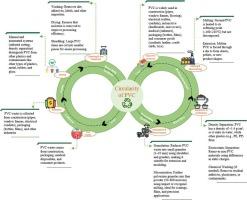聚氯乙烯在建筑环境中实现循环的作用:全面回顾
IF 11.2
1区 社会学
Q1 ENVIRONMENTAL STUDIES
引用次数: 0
摘要
世界正在努力应对管理塑料废物(PW)的巨大挑战,塑料废物每年超过4亿吨,是世界上最大、积累最快的废物流。聚氯乙烯(PVC)是一种多用途的合成聚合物,是第三大最畅销的商品塑料,用于各个行业。为了促进可持续发展和实施循环经济(CE)概念,再利用、再循环和再制造已成为PVC循环的优先事项。本研究考察了PVC循环的当前趋势,以及在将废物管理(WM)与实现CE实践联系起来的未来研究方向的差距。因此,采用了系统评价和荟萃分析首选报告项目(PRISMA)协议,并使用了两个数据库,即Scopus和Web of Science。系统文献综述的结果表明,PVC循环研究近年来取得了显著进展,重点是化学和机械回收,以及创造新的方法来提高材料回收率和降低毒性。然而,在循环导向的研究和探索PVC废物的有效回收过程中,差距仍然存在。应对这些挑战需要各方共同努力,改善利益相关者的协作,建立更好的沟通渠道,并投资于支持循环实践的基础设施。通过加强这些领域,PVC可以在增强循环性、减少环境影响和促进更广泛的可持续发展目标方面取得重大进展。研究结果建议优先考虑有效的回收方法、物料流分析和政策框架,以促进PVC向CE过渡,从而最大限度地减少对环境的影响和对资源的依赖。本文章由计算机程序翻译,如有差异,请以英文原文为准。

The role of polyvinyl chloride in achieving circularity in the built environment: A comprehensive review
The world is struggling with the enormous challenge of managing Plastic Waste (PW), which is over 400 million tonnes (Mt) annually and is the world's largest and most rapidly accumulating waste stream. Polyvinyl chloride (PVC), a versatile synthetic polymer, is the third most sold commodity plastic used in various industries. To promote sustainable development and implement the Circular Economy (CE) concepts, reuse, recycling, and remanufacturing have become priorities for PVC circularity. This research study examines the current trends in PVC circularity and gaps for future research directions in connecting Waste Management (WM) to achieve CE practices. Hence, the Preferred Reporting Items for Systematic Reviews and Meta-Analyses (PRISMA) protocol was undertaken, and two databases, namely Scopus and Web of Science, were used. The findings from the systematic literature review show that PVC circularity research has advanced significantly in recent years, with an emphasis on chemical and mechanical recycling as well as the creation of novel methods to improve material recovery and lower toxicity. However, gaps remain in circularity-directed research and in exploring efficient recycling processes for PVC waste. Addressing these challenges will require concerted efforts to improve stakeholder collaboration, build better communication channels, and invest in infrastructure supporting circular practices. By strengthening these areas, the PVC can make significant progress toward enhancing circularity, reducing environmental impact, and contributing to broader sustainability goals. The findings suggest prioritising effective recycling methods, material flow analysis, and policy frameworks to facilitate PVC's transition to a CE, consequently minimising environmental impact and resource dependency.
求助全文
通过发布文献求助,成功后即可免费获取论文全文。
去求助
来源期刊

Environmental Impact Assessment Review
ENVIRONMENTAL STUDIES-
CiteScore
12.60
自引率
10.10%
发文量
200
审稿时长
33 days
期刊介绍:
Environmental Impact Assessment Review is an interdisciplinary journal that serves a global audience of practitioners, policymakers, and academics involved in assessing the environmental impact of policies, projects, processes, and products. The journal focuses on innovative theory and practice in environmental impact assessment (EIA). Papers are expected to present innovative ideas, be topical, and coherent. The journal emphasizes concepts, methods, techniques, approaches, and systems related to EIA theory and practice.
 求助内容:
求助内容: 应助结果提醒方式:
应助结果提醒方式:


